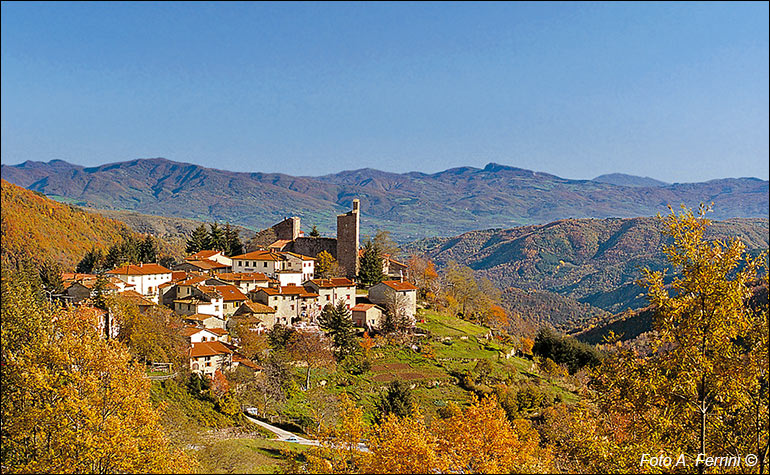Da Vallombrosa sul crinale del Pratomagno
un itinerario sul Monte Secchieta e sulle pendici nord del Pratomagno
Italiano
VALLOMBROSA, SECCHIETA, CROCE AL CARDETO 65
Trovandosi in Casentino, la strada più breve per raggiungere Monte Secchieta e Vallombrosa è quella che passa per Montemignaio. All’andata, o al ritorno, consigliamo una sosta in questo interessante borgo di origine medievale che è mostrato nella foto come ci appare scendendo da Monte Secchieta. Sul profilo della catena montuosa, all’orizzonte, vediamo l’inconfondibile “sperone” del Monte della Verna. L’intera zona di Montemignaio era sotto il dominio dei Guidi fin dall’XI secolo. Un territorio importante, perché una sorta di avamposto verso Firenze. Un motivo valido per costruirvi un castello nel XIII secolo. Di questo sono ancora presenti una torre e parte delle mura. Vi è anche una bella porta, ma questa fu aperta nel XIX secolo. Oltrepassatala, il piccolo borgo è molto gradevole da visitare. Interessante è l’oratorio di Sant’Agata che ha avuto origine da una cappella costruita nella prima metà del XIV secolo e il cui portale presenta un chiaro stile gotico. Sulla lunetta si trova lo stemma dell’Arte della Lana. L’importante azienda fiorentina ebbe certamente stretti rapporti commerciali con questo luogo di pastori quando nella seconda metà del Trecento Firenze subentrò ai Guidi nel dominio della zona. Per approfondimenti su questo borgo montano di Casentino visita questa sezione. https://www.ilbelcasentino.it/montemignaio.html Being in Casentino, the shortest way to reach Monte Secchieta and Vallombrosa is the one that passes through Montemignaio. On the outward journey, or on the return journey, we recommend a stop in this interesting village of medieval origin which is shown in the photo as it appears to us descending from Monte Secchieta. On the profile of the mountain range, on the horizon, we see the unmistakable "spur" of Monte della Verna. The entire Montemignaio area was under the Guidi family as early as the 11th century. It was an important territory, being a sort of outpost towards Florence, a valid reason to build a castle there in the 13th century. A tower and part of the walls are still visible. There is also a beautiful gate, but this was opened in the 19th century. Beyond it, the small village is very pleasant to visit. The oratory of Sant’Agata is interesting. It originated from a chapel built in the first half of the 14th century and its portal is clearly Gothic in style. In the lunette there is the coat of arms of the Arte della Lana. The important Florentine company certainly had close trade relations with this shepherd’s place when Florence took over from the Guidi in the second half of the 14th century. For further information on this mountain village of Casentino, visit this section. https://www.ilbelcasentino.it/montemignaio-en.php


















































































